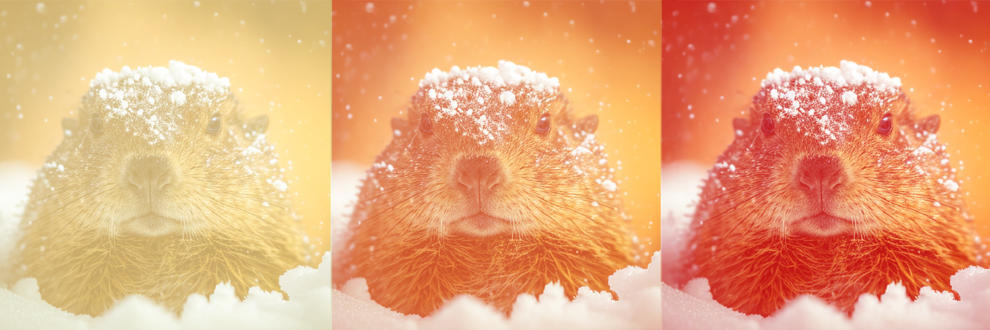
GROUNDHOGS – NATURE’S AUGURS
Every year, on February 2nd, I ask myself, “What will my local groundhog do?” As a person who was never particularly enthusiastic about winter, I approach the day with some hope of an early spring, mixed with trepidation if the rodent in question fails to predict my desired outcome.
As a New York City (NYC) resident, my local groundhog is none other than Staten Island Chuck who is currently being played by a groundhog named Charlotte Jr. No matter what Charlotte Jr. decides to predict on February 2nd, at least there’s never been a Groundhog Day that I’ve been forced to repeat over and over again in a seemingly infinite time loop.
GHOSTS OF WINTERS PAST
As with many yearly traditions, Groundhog Day serves as a reminder of years past and the cyclical nature of time. I am reminded of winter’s past and some of the more notable weather news stories of recent years – for example, 2010’s Blizzageddon. The snowstorm which started on Boxing Day 2010 resulted in 20 to 30 inches of snow across the New York City metro area, massive numbers of flights canceled, and citizens stuck overnight in subway cars.
Or the Polar Vortex in 2014, which featured quickly plummeting temperatures and blanketed much of the United States in the frigid cold. And then there’s the increasingly frequent Thundersnow, which is exactly what it sounds like (it’s cool, but also terrifying and weird).
This winter has only been notable for its absence of extreme cold weather events. In fact, the New York City metro area is in (at the time of writing) its second-longest stretch without measurable snow, and we’re likely to make it into the top spot. Also, this year, instead of thundersnow, we have January thunderstorms – not quite as exciting, but still not typical weather.
As Groundhog Day approaches, reflecting on winter’s past and present makes me wonder how different future winters will be. While these newsworthy events are instances of dramatic weather, they are one symptom of a rapidly changing climate, which is taking place on a global scale.
GROUNDHOG DAY WILL NEVER BE THE SAME
Scientists have shown that human activity resulting in increased greenhouse gas (GHG) emissions are accelerating global climate change, and as a result, we can expect droughts, catastrophic weather events, extreme heat waves, water scarcity, and other dramatic events. These events have and will continue to impact the most vulnerable populations of the world and disrupt societies and economies.
While I do not know what the groundhog will predict this year, I do know that Groundhog Days of the past will likely be very different from what’s ahead, at least in terms of climate. Groundhog Day, as a milestone meant to signal the possible end of winter, loses its significance, especially if winters don’t really happen in the same way anymore, due to global climate shifts.
In my area, these climate shifts are already having tangible impacts. According to the New York State Department of Environmental Conservation,
“Rising annual temperatures are already having widespread impacts on New York’s communities and ecosystems, and impacts are expected to increase. New York State’s changing climate may no longer be able to support the types of plants, insects, and wildlife living in New York, particularly those in high-elevation regions like the Catskills and Adirondacks. As New York’s temperatures increase, these species will extend their range north, impacting the industries and economies that depend on them such as fishing, hunting, and tourism.” [1]
These impacts are only a fraction of the immense change that’s underfoot. Events like Superstorm Sandy resulted in deaths, severe economic damage, and crippled the region’s infrastructure. Arguably, more than ten years later, NYC has not fully recovered – demonstrated by the region’s more frequent and intense rainstorms that seem to flood the subways regularly and further exacerbate unresolved damage.
It’s not just the NYC area’s climate that is changing – these changes are global. And the issue isn’t just that the climate is changing, but that the rate at which it’s going is having catastrophic consequences on societies, economies, and people’s lives. Across the globe, fires, droughts, hurricanes, and other extreme weather events are resulting in the loss of human life and mass migrations (often among economically disadvantaged citizens of the global south) as well as geopolitical strife.
SAVE GROUNDHOG DAY
What do we do about this? The UN’s Climate Change Conference in 2015 reached an international agreement to limit GHG emissions to curb global temperature increase to 2 degrees Celsius while also attempting to further limit it to 1.5 degrees Celsius. Current research shows that we are at a high likelihood of reaching the 1.5-degree limit from 2022 – 2026. The challenge to address GHG emissions becomes even more urgent.
Leaders and citizens, local and global governments, and organizations must work in concert to achieve these emissions reductions through energy-efficient building stock, increasing grid-scale renewables, and enacting sustainable land use and transportation planning. It’s a tough task, but we have the tools to do this, starting with using research to understand the highest impact actions and how everyday people make decisions around environmental citizenship.
Maybe without winter as we once knew it, Groundhog Day becomes less of a marker of a transition to spring and more of a reminder of the work we must all do to stave off the worst impacts of global climate change and how we must include everyone in this transition.
[1]https://www.dec.ny.gov/energy/94702.html#:~:text=In%20New%20York%2C%20winters%20have,cover%2C%20and%20earlier%20spring%20snowmelt.
